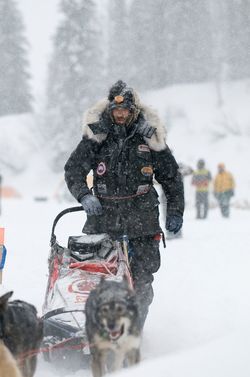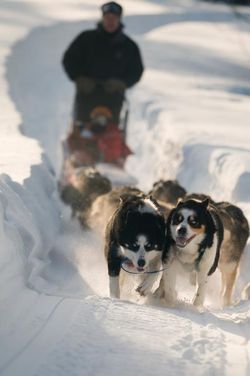
Seventy-one teams began the race this year, with 16 dogs each. Seventeen of the mushers were women. (see photo) finished in record time, just seconds under ninedays, making him the only four-time consecutive winner in history! Duringthe first days of the race, his team reportedly averaged6.8 miles per hour. By the end of the race, seven to eight days later, they were averaging over ten miles per hour.
Breeding, nutrition, training,and conditioning allow these canines to run in snow and over mountainsin extreme temperatures, going 100 miles a day while pulling a load. Theysleep only briefly in the snow and get a quick, warm, special meal before they’re at it again. Many dogs don’t even show any signs of wear.
But a number of dogs did drop out at each check point. At Finger Lake, 26 dogs dropped, largely due to pulled musclesand sore joints. Mackey began the race with a team of 16 dogs, and hefinished with only 11. Other mushers got down to as low as eight.

The sled dogs of today are primarily mixed breeds known as Alaskan Huskies. I saw some beautiful, purebred Siberian Huskies, but the most competitive teams are dogs of mixed genetics, producing a small dog of amazing athletic endurance. I was told that Siberian Husky, Alaskan Malamute, German Shepherd, Hounds, Bird Dog, Greyhound, Irish Setter, Collie, and other breeds are involved in the mix. The exact mixtures of the breeds seem to be tightly-held secrets. Many of these dogs look like mutts–smaller and much leaner/lighter than you would think for dogs that can pull heavy loads through grueling terrain and environmental conditions.
These are surely the most athletic of adventure dogs in the world, and the Pentagon would agree. In fact, government researchers are studying sled dogs to learn how to enhance human athleticism, as ���ϳԹ��� magazine wrote in its . The VO2 max in these dogs canreach 200. In comparison, when Lance Armstrong was in top shape for the Tour de France,his extraordinarily high human VO2 was around 85!
Fat seems to be the key tothese dogs’ remarkable endurance. Amazingly, they can run 100 to 130 miles a day, for nine to 12 days, with only short rest intervals. Many of them seem to gain energy, endurance, and enthusiasm as the race progresses,finishing in better condition than when they started. They have a stunning ability to convert food to energy. Their high fat diets (50- to 60-percent fat–enough to kill the normal hunting dog) contain fish, beef, added mixtures of fat, perhaps rice and specially-blended kibble, all cooked with water on a small, portable stove, prepared at rest stops by each musher. They also are fed a special “cake” of protein and fats. The feeding itself is an art, based upon weather, exertion, and the condition of each animal, all of which the musher judges at each stop.
No question, these are the most athletic canines on the planet. No other dog sport or competition comes close when you consider distance, time, terrain, and other environmental factors faced by these incredible animals.
–Mike Stewart,
Photos by